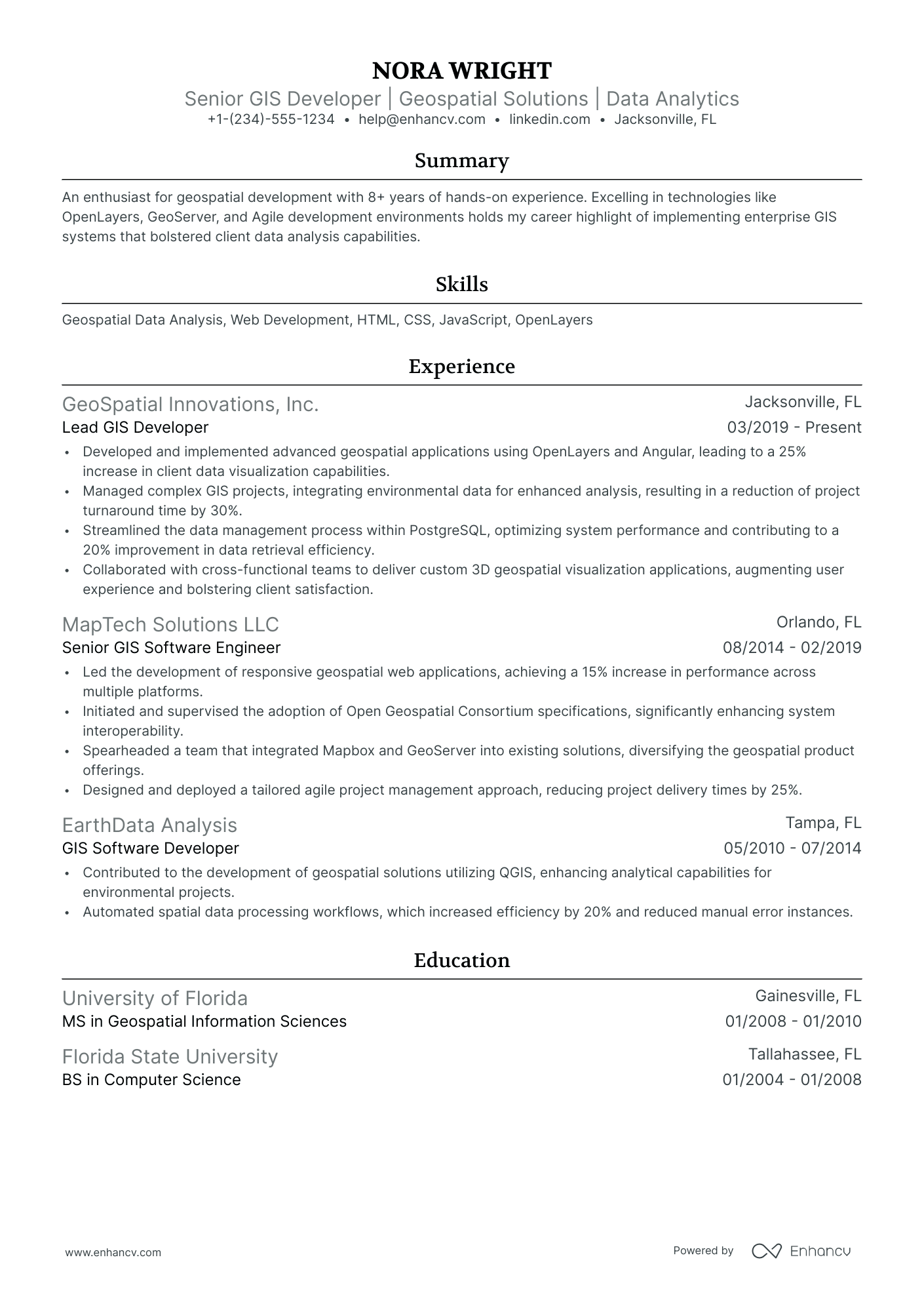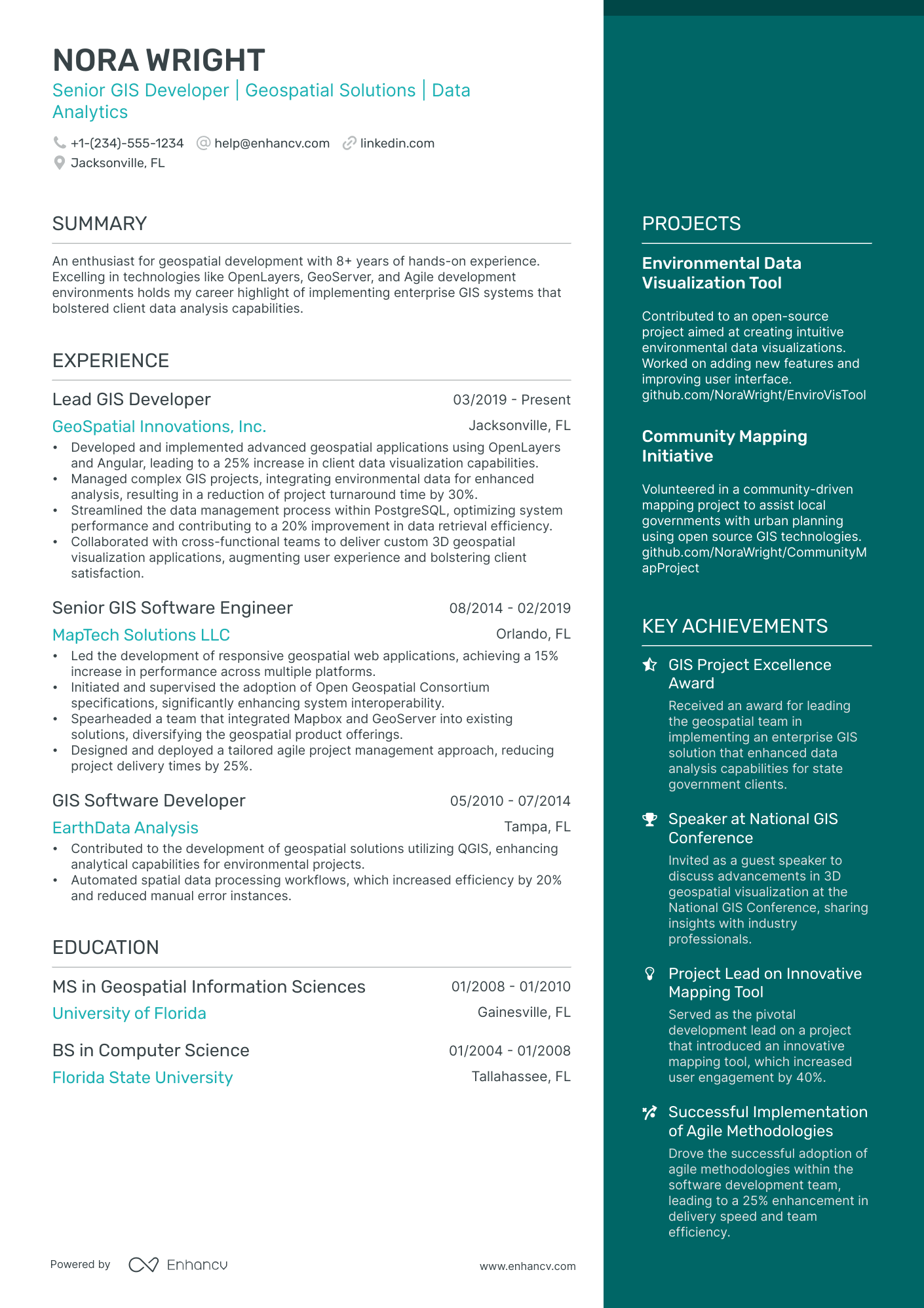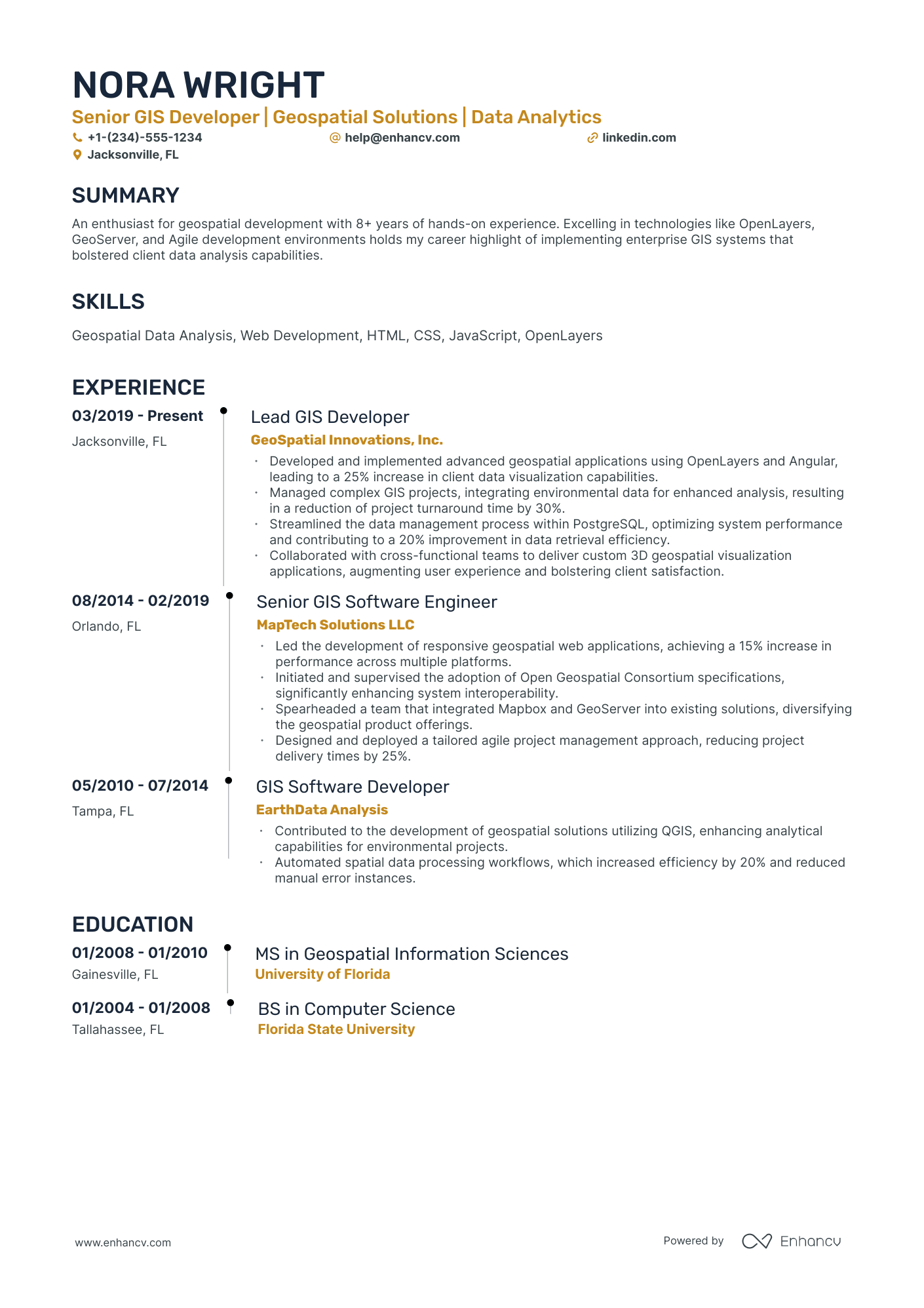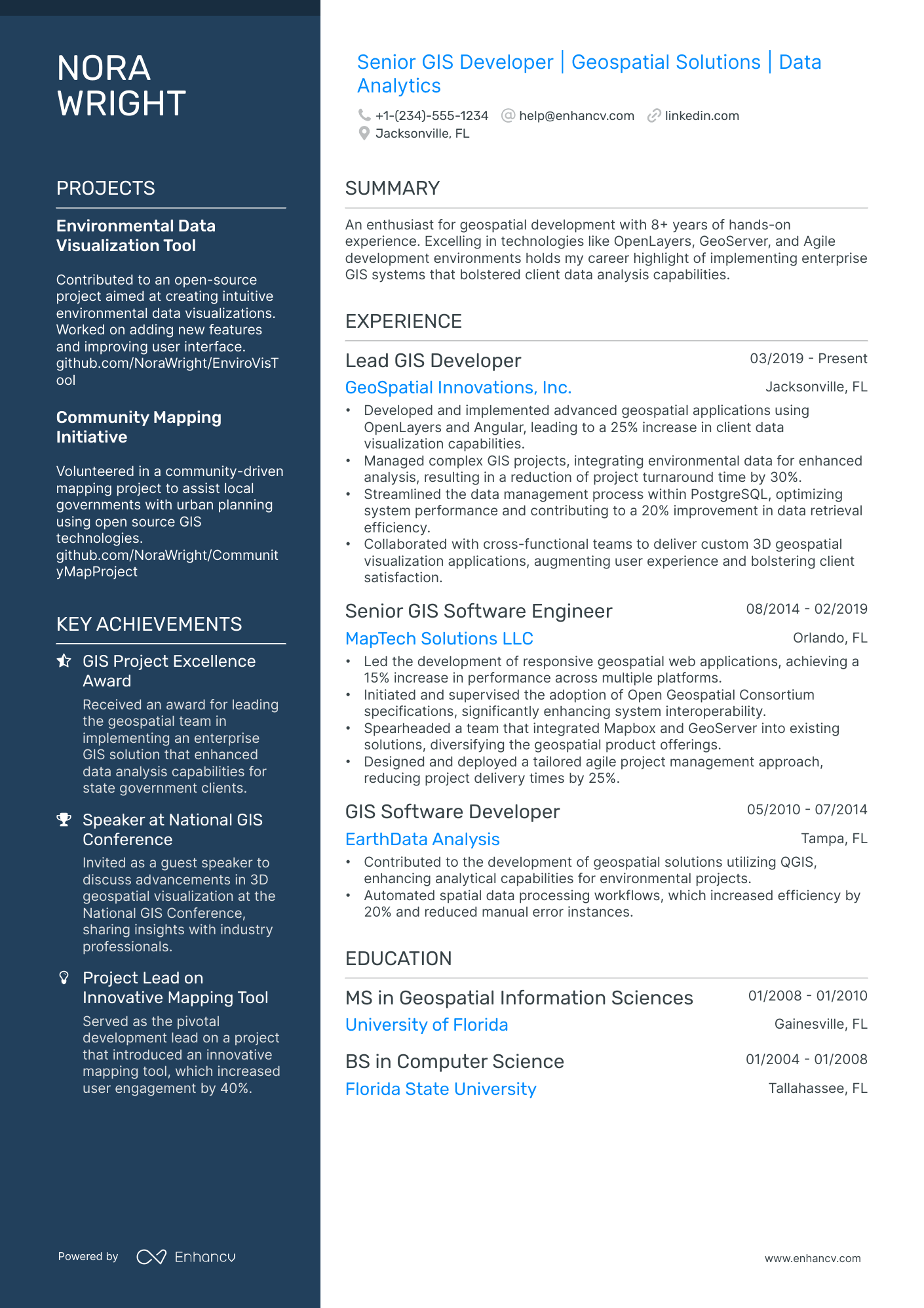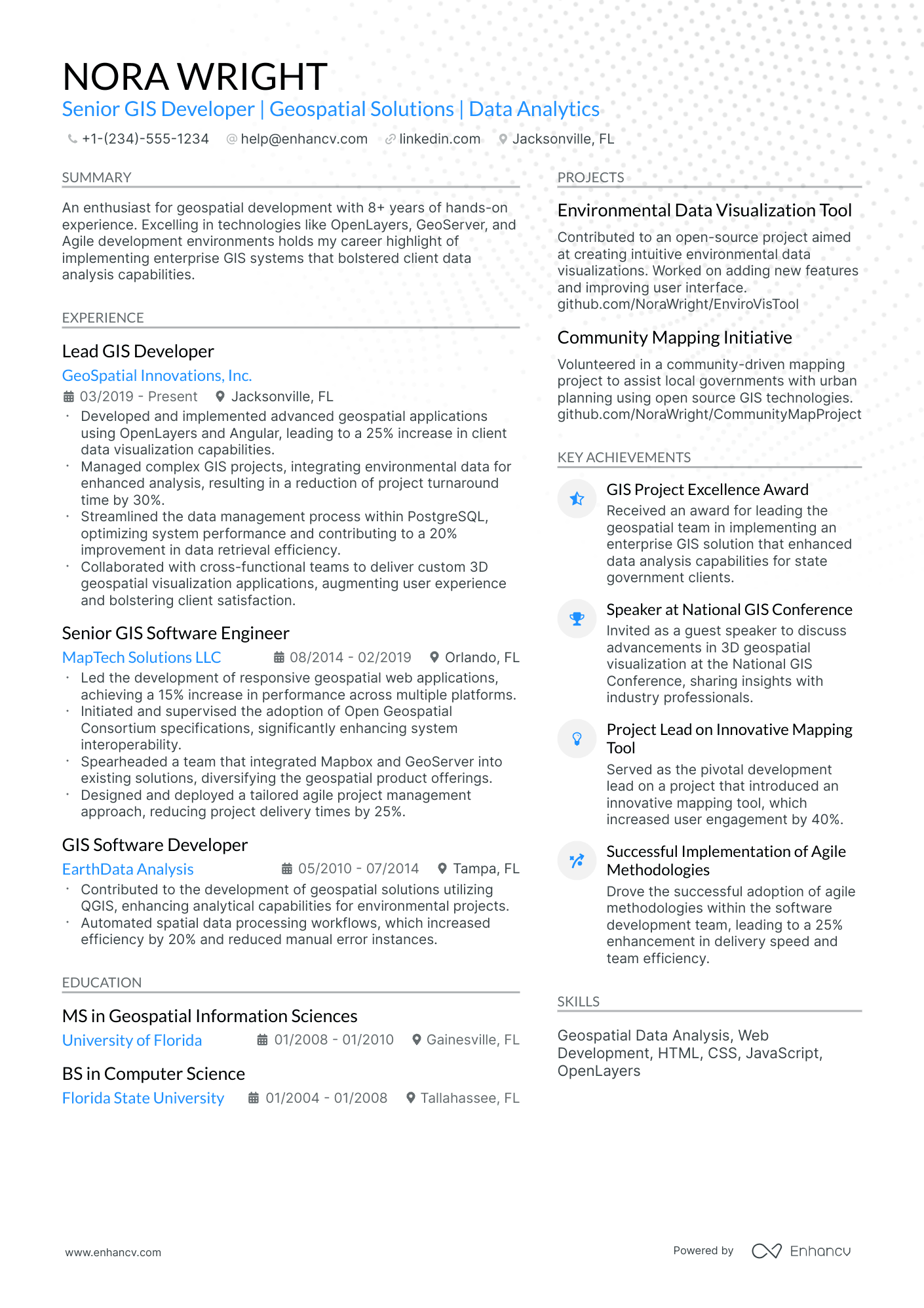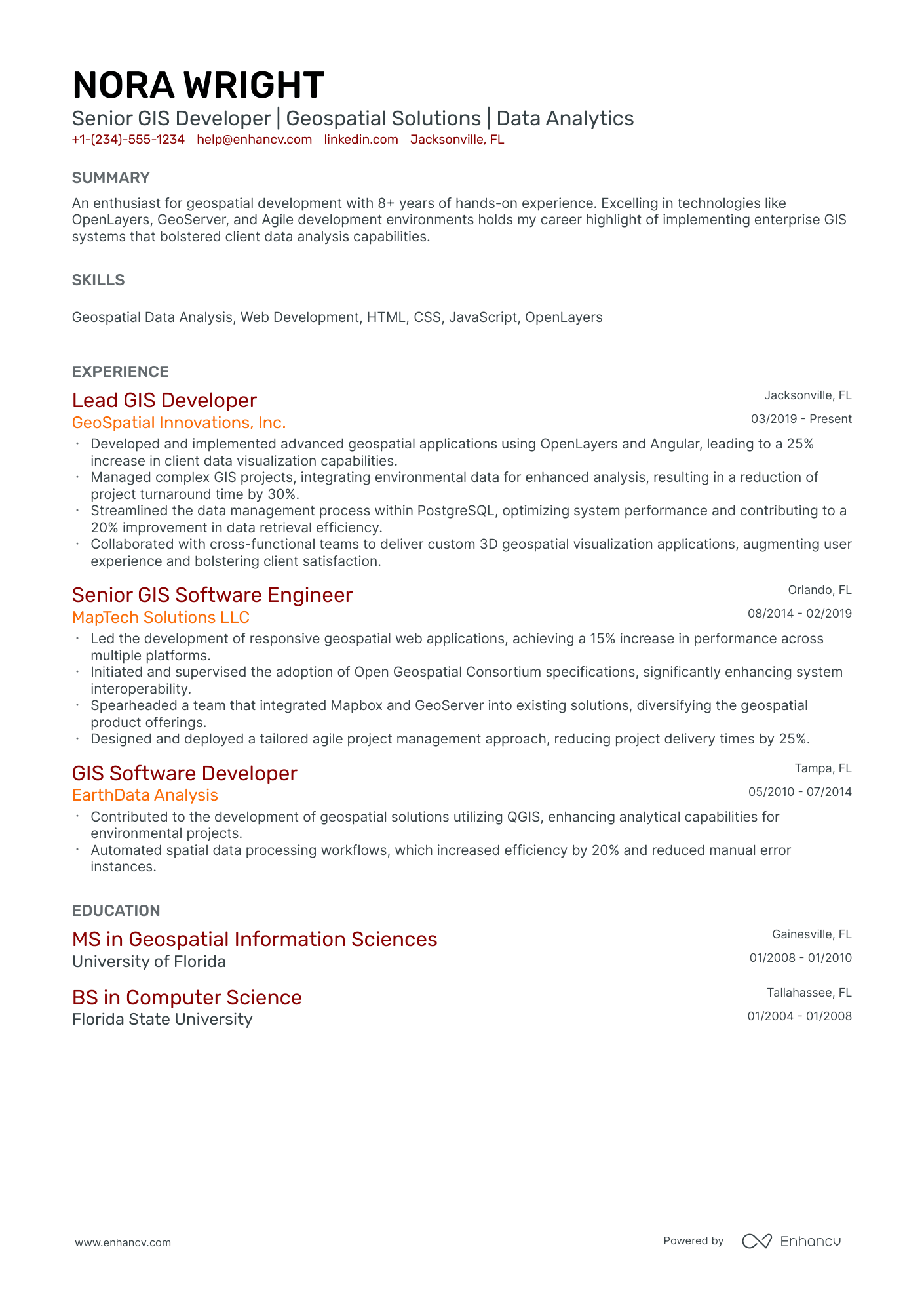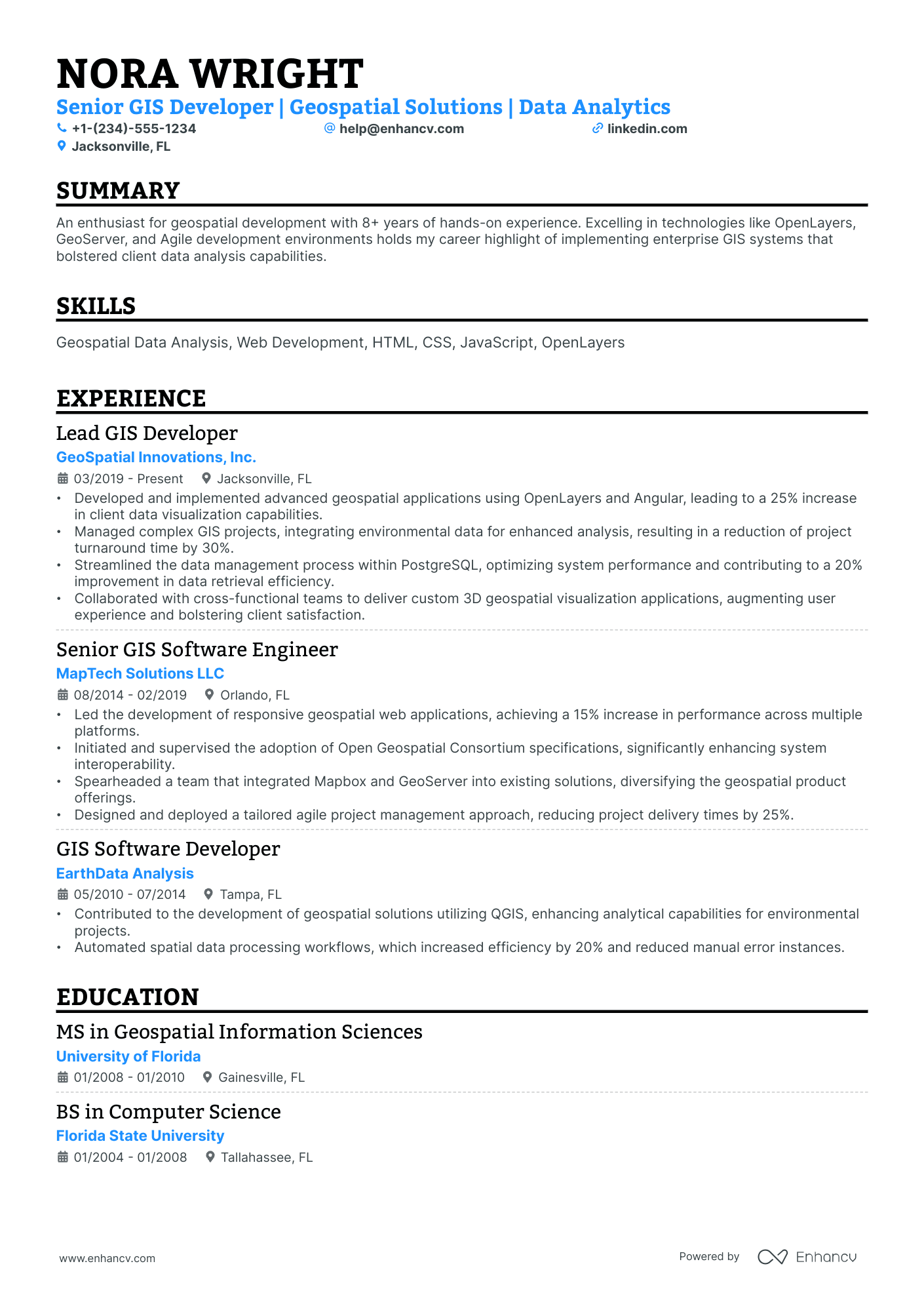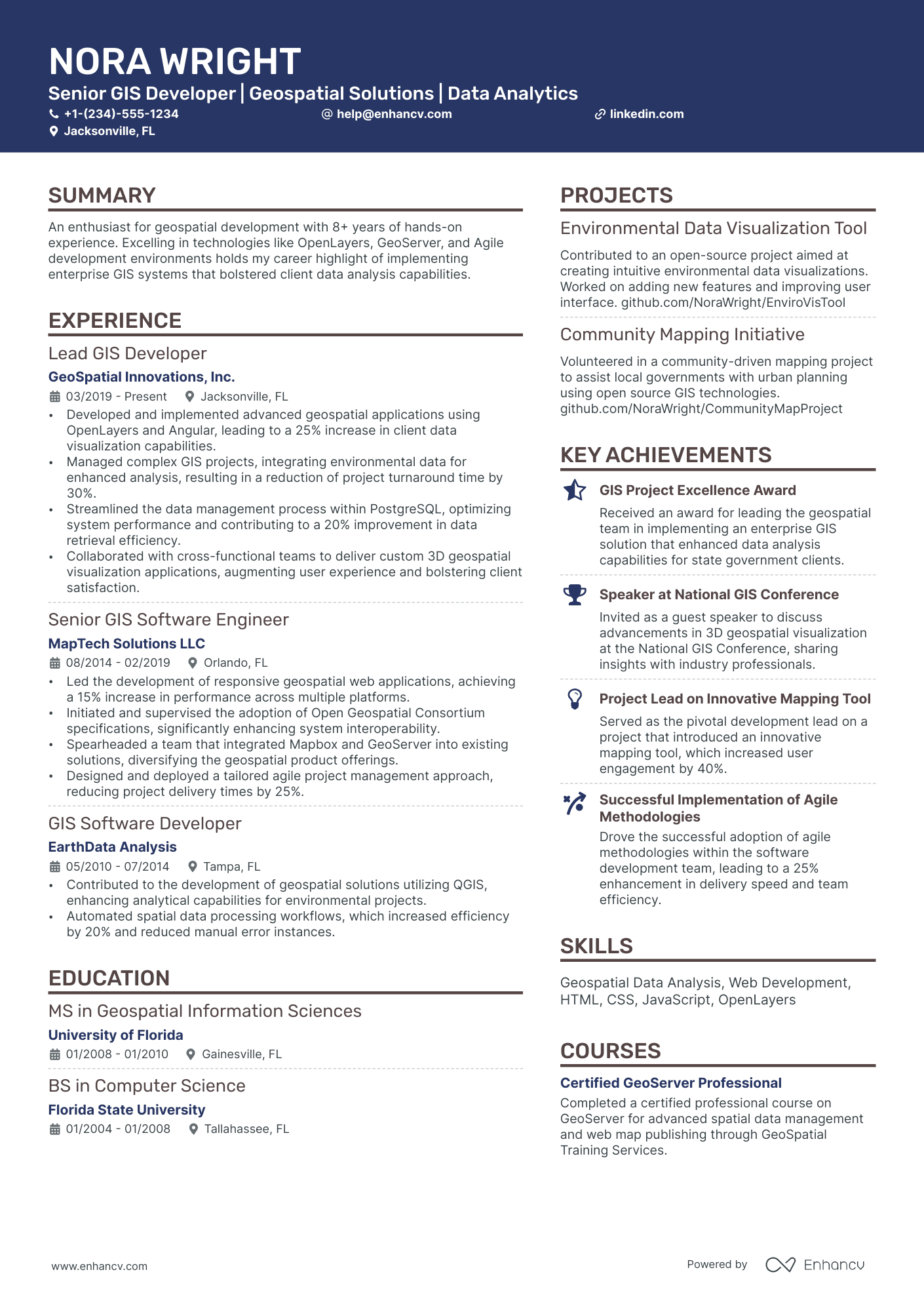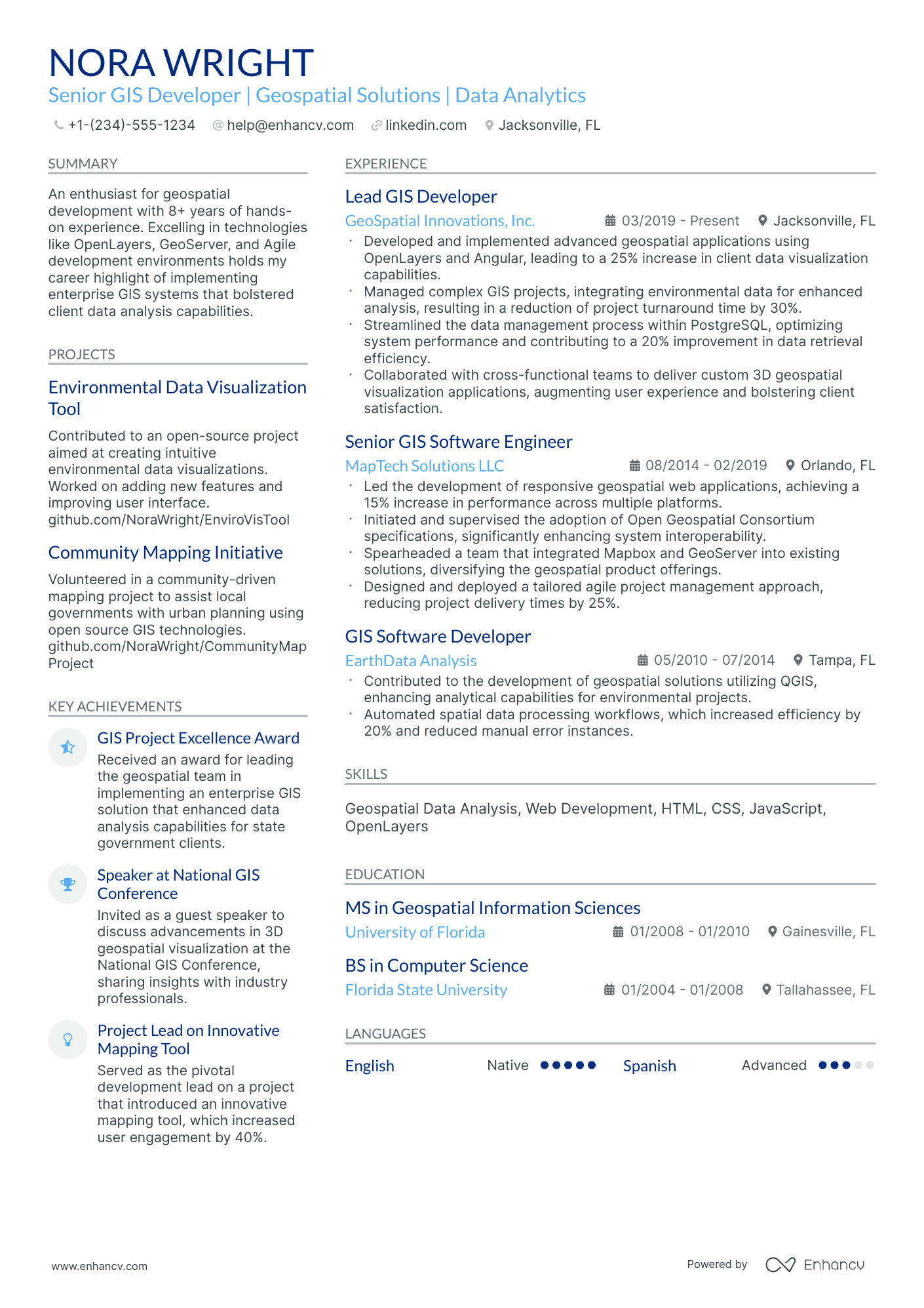As a GIS developer, articulating your complex technical projects and spatial analysis skills in a concise yet impactful way can be a significant resume challenge. Our expert-crafted guide provides you with clear strategies and examples to showcase your geospatial expertise effectively, ensuring your resume stands out to employers.
- Aligning the top one-third of your GIS developer resume with the role you're applying for.
- Curating your specific GIS developer experience to get the attention of recruiters.
- How to list your relevant education to impress hiring managers recruiting for the GIS developer role.
Discover more GIS developer professional examples to help you write a job-winning resume.
- Software Specialist Resume Example
- Senior Web Developer Resume Example
- QA Software Tester Resume Example
- Associate Software Engineer Resume Example
- Software Consultant Resume Example
- Asp.Net Developer Resume Example
- Software Business Analyst Resume Example
- Integration Developer Resume Example
- Software Product Manager Resume Example
- Director of Software Engineering Resume Example
GIS developer resume format made simple
You don't need to go over the top when it comes to creativity in your GIS developer resume format .
What recruiters care about more is the legibility of your GIS developer resume, alongside the relevancy of your application to the role.
That's why we're presenting you with four simple steps that could help your professional presentation check all the right boxes:
- The reverse-chronological resume format is the one for you, if you happen to have plenty of relevant (and recent) professional experience you'd like to showcase. This format follows a pretty succinct logic and puts the focus on your experience.
- Keep your header simple with your contact details; a headline that details the role you're applying for or your current job; and a link to your portfolio.
- Ensure your resume reaches an up-to-two-page limit, only if you happen to be applying for a more senior role or you have over a decade of relevant experience.
- Save your GIS developer resume as a PDF to retain its structure and presentation.
Upload & Check Your Resume
Drop your resume here or choose a file. PDF & DOCX only. Max 2MB file size.
PRO TIP
List your educational qualifications and certifications in reverse chronological order.
Don't forget to include these six sections on your GIS developer resume:
- Header and summary for your contact details and to highlight your alignment with the GIS developer job you're applying for
- Experience section to get into specific technologies you're apt at using and personal skills to deliver successful results
- Skills section to further highlight how your profile matches the job requirements
- Education section to provide your academic background
- Achievements to mention any career highlights that may be impressive, or that you might have missed so far in other resume sections
What recruiters want to see on your resume:
- Proficiency with GIS software such as ESRI ArcGIS, QGIS, or others, indicating experience with spatial analysis, geoprocessing, and data visualization.
- Experience with programming languages and technologies relevant to GIS development, like Python, SQL, JavaScript, and GIS-specific APIs or libraries (e.g., ArcPy, Leaflet, Mapbox).
- Knowledge of database management, particularly spatial databases like PostGIS, and skills in managing and analyzing large datasets.
- Understanding of geospatial concepts, such as coordinate systems, projections, and cartography, and the ability to apply this knowledge to solve complex spatial problems.
- Demonstrated experience in web mapping and development of GIS applications or services for web platforms, such as experience with web servers, REST API, or web services.
What to include in the experience section of your GIS developer resume
The resume experience section is perhaps the most important element in your application as it needs to showcase how your current profile matches the job.
While it may take some time to perfect your GIS developer experience section, here are five tips to keep in mind when writing yours:
- Assess the advert to make a list of key requirements and look back on how each of your past jobs answers those;
- Don't just showcase you know a particular skill, instead, you need proof in the form of tangible results (e.g. numbers, percent, etc.);
- It's perfectly fine to leave off experience items that don't bring anything extra to your skill set or application;
- Recruiters want to understand what the particular value is of working with you, so instead of solely featuring technologies, think about including at least one bullet that's focused on your soft skills;
- Take care with wording each bullet to demonstrate what you've achieved, using a particular skill, and an action verb.
The below GIS developer resume examples can help guide you to curate your professional experience, following industry-leading tips and advice.
- Developed an award-winning mapping application for municipal infrastructure management that improved data accuracy by 30% over previous solutions.
- Successfully integrated geospatial data with enterprise resource planning tools for streamlined asset management, reducing resource allocation errors by 25%.
- Spearheaded a team initiative to migrate legacy GIS systems to cloud-based platforms, enhancing system reliability and scalability while cutting operational costs by 20%.
- Automated spatial analysis processes using Python, which saved the team over 200 hours of manual work annually.
- Led the development of a mobile GIS solution for field data collection that boosted data collection efficiency by 35%.
- Designed and maintained a spatial database that supported resource management tasks, handling over 10TB of geospatial data.
- Collaborated on a multi-agency project to create a unified geospatial data repository, increasing data sharing efficiency by 40%.
- Optimized geospatial queries using PostGIS, reducing report generation time by over 50% for urban planning applications.
- Conducted extensive GIS training sessions, enhancing the spatial analysis skills of over 100 employees across various departments.
- Led a cross-functional team that developed a disaster response GIS platform used by emergency services to coordinate response efforts more effectively.
- Pioneered the use of machine learning algorithms in geospatial analysis, enhancing predictive modeling capabilities for urban development by 22%.
- Implemented rigorous system testing procedures, decreasing the bug rate by 15% and increasing software reliability.
- Developing a cutting-edge interactive 3D mapping interface that has improved client presentation and engagement metrics by over 45%.
- Integrating real-time geospatial analytics into business intelligence workflows, leading to a reduction in decision-making time by 30% for clients.
- Co-authored three publications on innovative use of GIS in environmental conservation, widely cited in academic and professional circles.
- Managed the migration of GIS data for a topographical change analysis project, which was instrumental in obtaining a £1.2 million grant for environmental research.
- Developed an automated anomaly detection tool for satellite imagery, resulting in a 20% increase in data processing throughput.
- Collaborated with international teams to standardize geospatial data formats, significantly reducing interoperability issues for global projects.
- Orchestrated the integration of a GIS-based asset tracking system that decreased loss rates by over 18% for a logistics client.
- Implemented an open-source GIS stack, reducing software license fees by $120,000 annually while maintaining operational performance.
- Received the 'Innovation in GIS Development' award for creating a versatile zoning analysis tool adopted by several urban planning agencies.
- Led the GIS module development for a natural resource exploration project, enhancing the detection of viable sites by 25%.
- Developed a patented method for efficient handling of multi-resolution geospatial data in web applications, benefiting numerous clients in the real estate sector.
- Conducted a department-wide security overhaul of GIS applications, fortifying system integrity and reducing vulnerability exposure by 40%.
Quantifying impact on your resume
- Document the size and complexity of the spatial databases you have managed, highlighting your proficiency in data organization and optimization.
- Specify the number of analysis projects completed, demonstrating your experience and ability to deliver results.
- Quantify any improvements in geospatial data processing times due to your optimizations, showing your skills in enhancing efficiency.
- Indicate the percent reduction in errors or increase in data accuracy that you achieved, showing your attention to detail.
- Mention the number of map layers or features you have created to illustrate your technical expertise in cartography and spatial analysis.
- List the number of cross-functional teams you have collaborated with, emphasizing your teamwork and communication skills.
- Highlight any percentage reduction in costs due to your innovative GIS solutions, proving your cost-saving capabilities for the business.
- Report the scale or reach of the GIS applications you've developed, such as the number of users or geographic extent, to showcase your impact on operations.
Action verbs for your GIS developer resume
GIS developer resume without experience: a walk-through guide
If you don't happen to have any relevant experience yet, you can substitute this with:
- Short-term gigs and stunts - like month-long internships, that you have done during your university days
- Contract work - be specific about the relevance and outcomes of each role you include
- Resume format that prioritizes your skills - the functional-skill-based format or hybrid format could work
- Research roles - feature those especially prominently if you've participated in a noteworthy project or your role was of utmost importance to the project's success.
Recommended reads:
PRO TIP
Highlight any significant extracurricular activities that demonstrate valuable skills or leadership.
Balancing hard and soft skills in your GIS developer resume
Recruiters indeed pay close attention to the specific hard and soft skills candidates possess. Hard skills refer to technical abilities or your proficiency in technologies, while soft skills are the personal attributes and qualities developed over your lifetime.
If you're unsure about effectively quantifying these skills on your resume, follow our step-by-step guide. It's crucial to first understand the key job requirements for the role. Doing so enables you to accurately list your:
- Hard skills in sections like skills, education, and certifications. Your technical expertise is straightforward to quantify. Most organizations find it sufficient to mention the certificates you've earned, along with your proficiency level.
- Soft skills within your experience, achievements, strengths, etc. Defining interpersonal communication traits in your resume can be challenging. Focus on showcasing the accomplishments you've achieved through these skills.
Remember, when tailoring your GIS developer resume, ensure that the skills you list match exactly with those in the job requirements. For instance, if the job listing specifies "Microsoft Word," include this exact term rather than just "Word" or "MSO."
Top skills for your GIS developer resume:
ArcGIS
QGIS
PostGIS
MapServer
Leaflet
OpenLayers
Python
JavaScript
SQL
Geospatial Analysis
Problem Solving
Attention to Detail
Communication
Team Collaboration
Critical Thinking
Time Management
Adaptability
Creativity
Project Management
Analytical Skills
PRO TIP
The more trusted the organization you've attained your certificate (or degree) from, the more credible your skill set would be.
What are the best certificates to add to your GIS developer resume + how to curate your education section
The education and certification resume sections are the underdogs of your GIS developer resume.
They showcase to recruiters that you've invested plenty of time to gain valuable and specific know-how, vital for growth.
As far as the resume education section is concerned:
- Detail only advanced education, specifying the institution and timeframe.
- Indicate your forthcoming graduation date if you're in the midst of your studies.
- Consider omitting degrees that don't align with the job's requirements.
- Offer a description of your academic journey if it underscores your notable achievements.
When curating your degrees and certificates on your GIS developer resume:
- Select only accreditation that matters to the role
- Niche knowledge that could help you stand out as a candidate (as is within the past few years), should be listed towards the top of your resume
- Include any pertinent data for credibility (e.g. institute name, graduation dates, etc.)
- Irrelevant degrees and certifications shouldn't make it on your resume. Those include your high school diploma and any specializations that have nothing to do with the technical or soft skills that are required for the job
As a final note, if you feel tempted to exclude your education or certification from your resume, don't.
These two sections could help you have a better competitive edge over other candidates - hinting that your professional journey in the industry may be for a longer period of time.
Recruiters find all of these GIS developer credentials impressive:
The top 5 certifications for your GIS developer resume:
- Esri Certified ArcGIS Desktop Professional (EADP) - Esri
- GIS Professional (GISP) - GIS Certification Institute
- Esri Technical Certification: Web Application Developer Associate (EWDA) - Esri
- Certified GIS Technician (CGT) - American Society for Photogrammetry and Remote Sensing (ASPRS)
- CompTIA GIS Technician Certificate - CompTIA
PRO TIP
If you happen to have some basic certificates, don't invest too much of your GIS developer resume real estate in them. Instead, list them within the skills section or as part of your relevant experience. This way you'd ensure you meet all job requirements while dedicating your certificates to only the most in-demand certification across the industry.
Recommended reads:
Deciding between a resume summary or objective for your GIS developer role
Understanding the distinction between a resume summary and an objective is crucial for your GIS developer resume.
A resume summary, typically three to five sentences long, offers a concise overview of your career. This is the place to showcase your most pertinent experience, key accomplishments, and skills. It's particularly well-suited for those with professional experience relevant to the job requirements.
In contrast, a resume objective focuses on how you can add value to potential employers. It addresses why they should hire you and outlines your career expectations and learning goals. Therefore, it's ideal for candidates with less experience.
In the following section of our guide, explore how resume summaries and objectives differ through some exemplary industry-specific examples.
Resume summaries for a GIS developer job
- With over 8 years of experience as a GIS developer, proficient in ESRI ArcGIS, Python scripting, and database management, I've successfully integrated geospatial software into large-scale transportation projects, enhancing operational efficiency and data visualization for decision-makers.
- Transitioning from a successful 10-year career in software development with a mastery of Java, JavaScript, and SQL, I recently completed a specialized certification in GIS technology aiming to leverage my robust programming background to innovate geospatial solutions.
- With nearly a decade of professional GIS development experience, my expertise lies in crafting custom mapping applications and spatial databases. I'm adept in advanced spatial analysis, and my work has been pivotal in developing emergency response systems that reduced incident response times by 30%.
- Coming from a data analytics background, I possess strong analytical skills and proficiency in R and Python. My recent GIS coursework and hands-on project experience position me to bring a fresh perspective on data-driven, location-based analysis and strategy development.
- Eager to translate my passion for geography and coding into a practical application, I seek a gateway into the GIS field. My solid foundation in computer science, coupled with active self-study in spatial analytics tools like QGIS and PostGIS, makes me ready to contribute effectively from the outset.
- Aiming to blend my enthusiasm for environmental science with technology, I'm determined to kickstart a career in GIS development. My recent volunteering experience with conservation projects and proficiency in data manipulation using Python exemplify my commitment to acquiring hands-on GIS skills.
Extra GIS developer resume sections and elements
Creating a winning GIS developer resume isn't about following a rigid formula. The key is to tailor it to the job requirements while maintaining your unique personality.
Consider including these additional resume sections to enhance your profile:
- Awards - Highlight industry-specific awards as well as any personal accolades to demonstrate recognition of your expertise and achievements;
- Hobbies and interests - Share your interests outside of work. This can provide insights into your personality and indicate whether you'd be a good cultural fit for the organization;
- Projects - Detail significant projects you've been involved in, focusing on your contributions and the outcomes;
- Publications - If you've authored or co-authored academic papers or other publications, include them to establish your credibility and in-depth knowledge of the field.
These sections can give a more comprehensive view of your capabilities and character, complementing the standard resume content.
Key takeaways
- The format and layout of your GIS developer resume should reflect on both your career and what matters most to the job you're applying for;
- Use the resume summary and objective to hint at your most prominent accomplishments;
- Always be specific about your experience and consider what value each bullet you curate adds to your GIS developer application;
- Consider how your academic background and technical capabilities could further showcase your alignment to the role;
- Your soft skills should contribute to your overall GIS developer profile - aligning your personality with skills and results.
